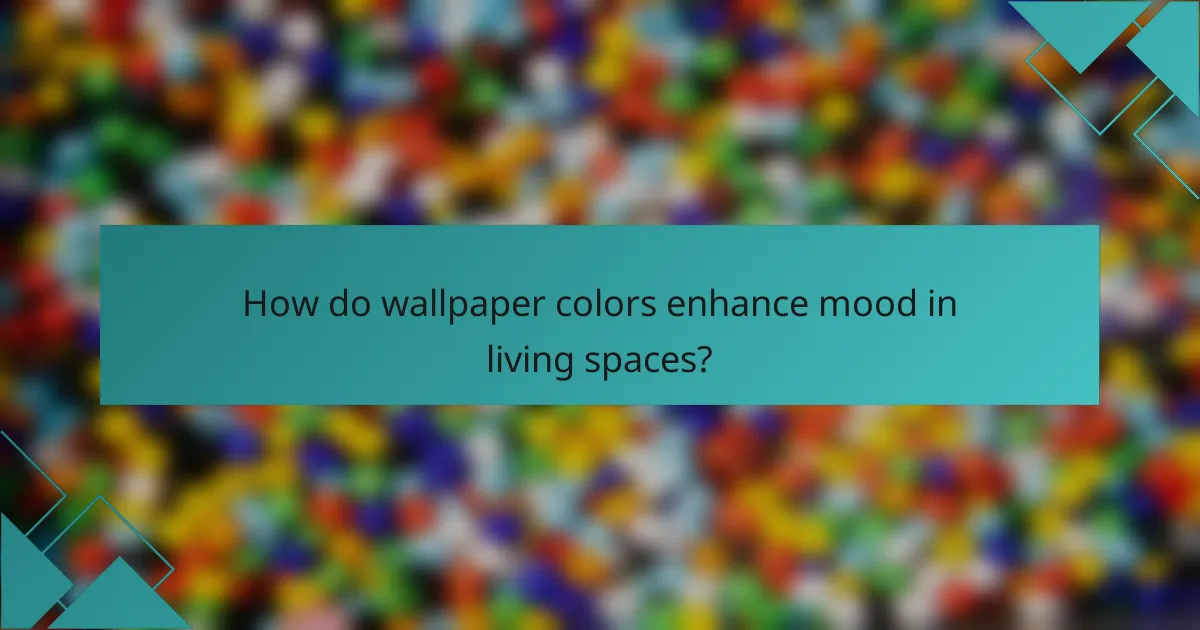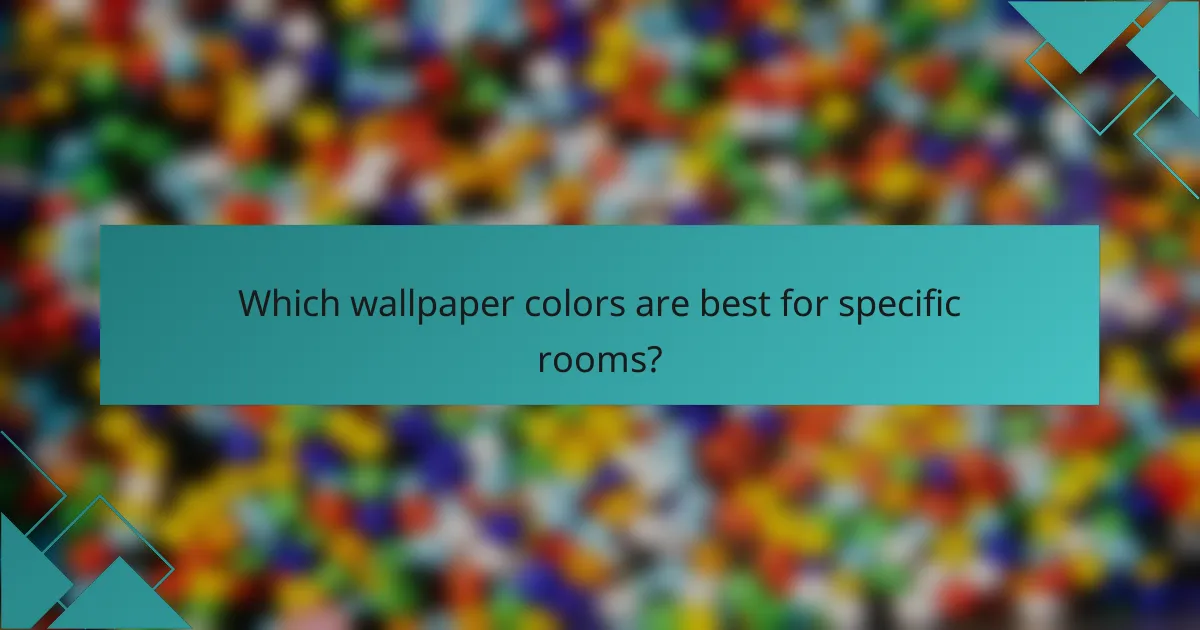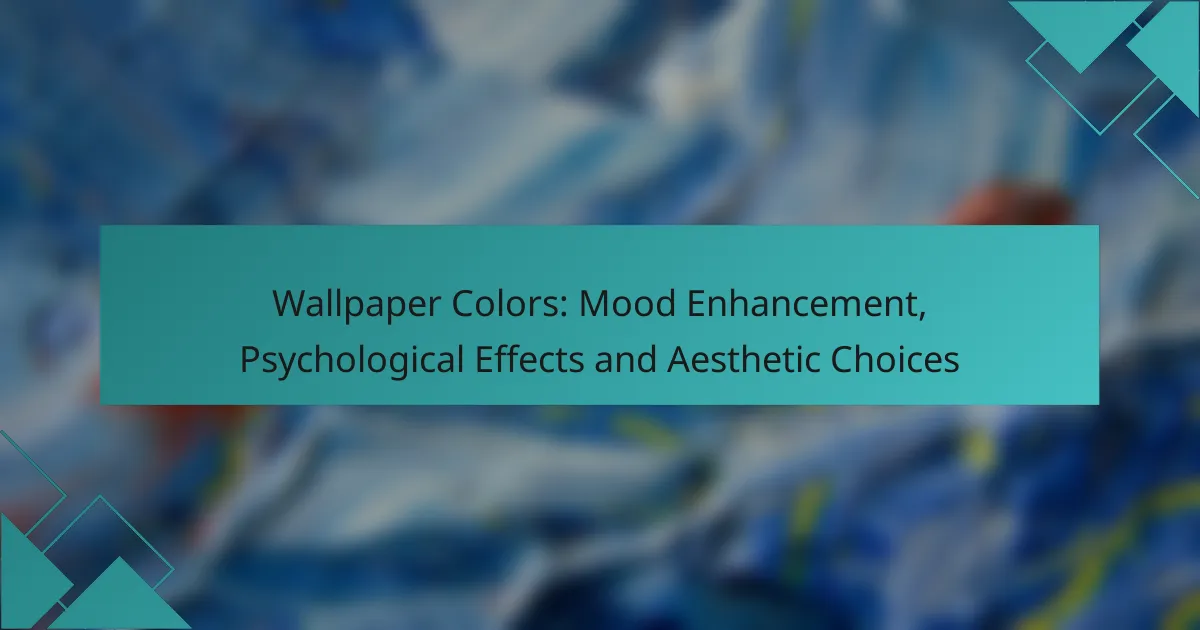Wallpaper colors play a crucial role in enhancing mood and shaping the atmosphere of living spaces. By carefully selecting hues, one can create environments that either energize or soothe, directly influencing emotions and behaviors. Understanding the psychological effects of different colors is essential for achieving the desired ambiance in each room.

How do wallpaper colors enhance mood in living spaces?
Wallpaper colors significantly enhance mood in living spaces by influencing emotions and perceptions. The choice of color can create an atmosphere that either energizes or calms, depending on the desired effect.
Warm colors promote energy and excitement
Warm colors like reds, oranges, and yellows are known to stimulate energy and evoke feelings of excitement. These hues can make a space feel more vibrant and inviting, making them ideal for areas where social interaction occurs, such as living rooms or dining areas.
When using warm colors, consider the intensity and saturation. Bright, bold shades can create a lively environment, while softer warm tones can add warmth without overwhelming the senses. A good approach is to use warm colors as accents, such as in wallpaper patterns or feature walls.
Cool colors create calm and relaxation
Cool colors, including blues, greens, and purples, are associated with tranquility and relaxation. These shades can help reduce stress and create a soothing atmosphere, making them perfect for bedrooms or home offices where focus is essential.
To maximize the calming effect, opt for softer, muted versions of cool colors. Light blues or soft greens can create a serene environment, while deeper shades can add depth and sophistication. Pairing cool colors with natural light can enhance their relaxing qualities.
Neutral colors provide balance and versatility
Neutral colors such as whites, grays, and beiges offer balance and versatility in interior design. They serve as a backdrop that allows other colors to stand out, making them suitable for any room in the house.
Using neutral colors can help create a cohesive look throughout your living space. They can be easily paired with both warm and cool accents, allowing for flexibility in decor styles. When choosing neutrals, consider the undertones to ensure they complement other colors in the room.

What psychological effects do different wallpaper colors have?
Different wallpaper colors can significantly influence mood and behavior. Each color evokes specific emotions and psychological responses, making it essential to choose wisely based on the desired atmosphere in a space.
Red increases passion and urgency
Red is a powerful color that can evoke feelings of passion, energy, and urgency. It is often associated with strong emotions such as love and excitement, making it suitable for spaces where you want to inspire action or stimulate conversation.
However, too much red can lead to feelings of aggression or anxiety. It’s best used as an accent color in areas like dining rooms or creative spaces, where a burst of energy is beneficial without overwhelming the senses.
Blue fosters tranquility and focus
Blue is known for its calming effects, promoting tranquility and focus. It can help reduce stress and create a serene environment, making it ideal for bedrooms, offices, or study areas.
When using blue wallpaper, consider lighter shades for a more soothing effect, while darker blues can add depth and sophistication. Balance is key; pairing blue with warmer tones can enhance its calming properties without making the space feel cold.
Yellow stimulates creativity and optimism
Yellow is often linked to happiness, creativity, and optimism. It can brighten a room and uplift spirits, making it a great choice for creative spaces like studios or playrooms.
However, excessive yellow can be overwhelming, so it’s best to use it in moderation or as an accent. Pairing yellow with neutral colors can help maintain a cheerful yet balanced atmosphere, ensuring the space remains inviting and energizing.

Which wallpaper colors are best for specific rooms?
Choosing the right wallpaper colors for different rooms can significantly influence the mood and functionality of each space. Warm tones are often ideal for social areas, while cool tones promote relaxation in bedrooms, and energizing colors can enhance productivity in home offices.
Living room: warm tones for social interaction
Warm tones such as reds, oranges, and yellows create an inviting atmosphere in living rooms, encouraging social interaction. These colors can stimulate conversation and foster a sense of comfort among guests.
When selecting warm wallpaper, consider the intensity of the color. Softer shades can create a cozy environment, while bolder hues might energize the space. Pairing warm tones with neutral furniture can balance the vibrancy and maintain a welcoming ambiance.
Bedroom: cool tones for restful sleep
Cool tones like blues, greens, and soft purples are ideal for bedrooms, promoting relaxation and restful sleep. These colors can help lower stress levels and create a tranquil environment conducive to unwinding at the end of the day.
Opt for lighter shades of cool colors to enhance the feeling of spaciousness and calm. Darker hues can work well if balanced with adequate lighting and soft furnishings, ensuring the room remains serene and inviting.
Home office: energizing colors for productivity
In a home office, energizing colors such as bright greens, yellows, and even some shades of orange can boost creativity and productivity. These colors stimulate the mind and can help maintain focus during work hours.
When choosing wallpaper for your office, consider using accent walls to introduce these vibrant colors without overwhelming the space. Combining energizing hues with functional decor can create an inspiring environment that enhances work performance.

How to choose wallpaper colors based on personal style?
Choosing wallpaper colors that reflect your personal style involves considering your tastes, the existing elements in your space, and how colors can influence mood. Start by identifying colors that resonate with you and complement your home’s overall aesthetic.
Consider existing furniture and decor
Your wallpaper should harmonize with your current furniture and decor. Take note of the dominant colors and styles in your room; for instance, if you have warm wooden furniture, earthy tones or warm neutrals may work best. Avoid colors that clash with major pieces to maintain a cohesive look.
Additionally, consider the scale and pattern of your furniture. Large, bold patterns may require more subdued wallpaper to avoid overwhelming the space. Aim for a balance that enhances both the wallpaper and the furnishings.
Reflect personal preferences and lifestyle
Your wallpaper choice should mirror your personal preferences and lifestyle. If you enjoy a calm and serene environment, softer colors like pastels or muted tones may be ideal. Conversely, if you prefer a vibrant and energetic atmosphere, consider bolder colors or dynamic patterns.
Think about how you use the space. For example, a home office might benefit from colors that promote focus, such as blues or greens, while a living room could embrace warmer tones to create a welcoming ambiance. Your lifestyle should guide your choices to ensure the space feels comfortable and inviting.
Use color swatches for testing
Before committing to a wallpaper color, test swatches in your space. Purchase small samples and apply them to the wall to see how they look at different times of the day. Lighting can significantly affect how colors appear, so observe the swatches in both natural and artificial light.
Consider placing swatches next to furniture and decor to assess compatibility. This hands-on approach helps avoid costly mistakes and ensures that the final choice aligns with your vision for the room.

What are the current trends in wallpaper colors?
Current trends in wallpaper colors emphasize a blend of boldness and subtlety, catering to diverse aesthetic preferences. Homeowners are increasingly drawn to colors that not only enhance the mood of a space but also reflect personal style.
Bold patterns and vibrant hues
Bold patterns and vibrant hues are making a significant impact in interior design, offering a way to create striking focal points in any room. Colors like deep blues, rich greens, and fiery reds can energize a space and evoke strong emotions.
When selecting bold wallpapers, consider the size of the room; larger spaces can handle more intense colors and patterns, while smaller areas may benefit from a single accent wall. Pairing bold wallpaper with neutral furniture can help balance the overall look.
Earthy tones for a natural feel
Earthy tones, such as terracotta, olive green, and warm browns, are gaining popularity for their ability to create a calming, natural atmosphere. These colors often evoke feelings of comfort and connection to nature, making them ideal for living rooms and bedrooms.
To enhance the effect of earthy tones, incorporate natural materials like wood and stone in your decor. This combination can create a harmonious environment that promotes relaxation and well-being.
Pastel shades for a soft aesthetic
Pastel shades, including soft pinks, light blues, and gentle yellows, are favored for their ability to create a serene and inviting ambiance. These colors work well in spaces intended for relaxation, such as nurseries or reading nooks.
When using pastels, consider layering different shades to add depth without overwhelming the space. Pairing pastels with white or light wood furnishings can enhance the airy feel and keep the room feeling open and bright.

How do cultural influences affect wallpaper color choices?
Cultural influences significantly shape wallpaper color choices, as different societies associate specific colors with various meanings and emotions. These associations can affect preferences for color schemes in homes and public spaces, reflecting local traditions, values, and aesthetics.
Regional color preferences vary widely
Color preferences can differ dramatically from one region to another, influenced by factors such as climate, geography, and cultural heritage. For instance, warmer climates often favor bright, vibrant colors that reflect the natural environment, while cooler regions may lean towards muted, earthy tones.
In many Western cultures, colors like blue and green are commonly associated with calmness and tranquility, making them popular choices for bedrooms and relaxation spaces. In contrast, in some Asian cultures, red is favored for its symbolism of luck and prosperity, often used in living areas and during celebrations.
When selecting wallpaper, consider local trends and cultural significance. Researching regional preferences can help ensure that your choices resonate well with the intended audience or inhabitants of the space.
